Page 439 - My FlipBook
P. 439
MANAGEMENT OF CAVITIES BY CLASSES. 203
MANAGEMENT OF CAVITIES BY CLASSES.
.
Under this heading it is the intention to discuss the relation
that the treatment of caries should bear to the local conditions of
its causation, the intensity of susceptibility of the individual and
the changes in susceptibility and immunity which may occur as
patients become older. This will include the time in the life of
the individual of the occurrence of the different classes of cav-
ities and some notes on recurrence of decay at unusual times.
Classificatidk.
Class 1. Cavities beginning in pits and fissures in any parts
of the teeth in which these occur.
Class 2. Cavities beginning in the proximal surfaces of the
bicuspids and molars.
Class 3. Cavities beginning in the proximal surfaces of the
incisors and cuspids which do not require the removal and
restoration of the incisal angle.
Class 4. Cavities beginning in the proximal surfaces of the
incisors which require the removal and restoration of the incisal
angle.
Class 5. Cavities beginning in the gingival third — not pit
or fissure cavities — of the labial, buccal or lingual surfaces of
the teeth.
This classification is especially intended for use in technical
procedures. But, as it is also a classification of cavities which
expresses the order in which they most frequently occur in the
age of the individual, it will be of use here in bringing the ques-
tions at issue in more orderly form.
Caries of the teeth presents considerable differences when
occurring in different localities in the mouth or upon different
surfaces of the teeth, and at different ages of patients that call
for differences in the management of cases. Occasionally all
classes of cavities will be found in the same mouth and require
treatment at the same time. This is comparatively rare, but
when it occurs in a young person the case is a very grave one.
The rule is that in very susceptible persons, particular classes
of cavities make their beginnings at about a certain time after
each of the several teeth has taken its place in the arch. This
certain time will be early or late with different patients, accord-


